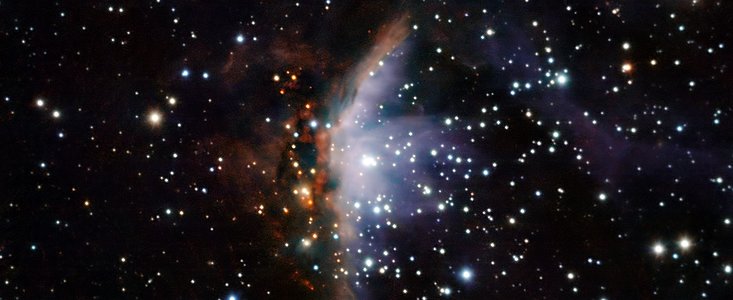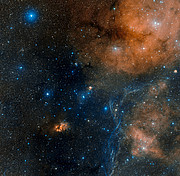Press Release
The Light and Dark Face of a Star-Forming Nebula
31 March 2010
Today, ESO is unveiling an image of the little known Gum 19, a faint nebula that, in the infrared, appears dark on one half and bright on the other. On one side hot hydrogen gas is illuminated by a supergiant blue star called V391 Velorum. New star formation is taking place within the ribbon of luminous and dark material that brackets V391 Velorum’s left in this perspective. After many millennia, these fledgling stars, coupled with the explosive demise of V391 Velorum as a supernova, will likely alter Gum 19’s present Janus-like appearance.
Gum 19 is located in the direction of the constellation Vela (the Sail) at a distance of approximately 22 000 light years. The Gum 19 moniker derives from a 1955 publication by the Australian astrophysicist Colin S. Gum that served as the first significant survey of so-called HII (read “H-two”) regions in the southern sky. HII refers to hydrogen gas that is ionised, or energised to the extent that the hydrogen atoms lose their electrons. Such regions emit light at well-defined wavelengths (or colours), thereby giving these cosmic clouds their characteristic glow. And indeed, much like terrestrial clouds, the shapes and textures of these HII regions change as time passes, though over the course of eons rather than before our eyes. For now, Gum 19 has somewhat of a science fiction-esque, “rip in spacetime” look to it in this image, with a narrow, near-vertical bright region slashing across the nebula. Looking at it, you could possibly see a resemblance to a two-toned angelfish or an arrow with a darkened point.
This new image of the evocative Gum 19 object was captured by an infrared instrument called SOFI, mounted on ESO’s New Technology Telescope (NTT) that operates at the La Silla Observatory in Chile. SOFI stands for Son of ISAAC, after the “father” instrument, ISAAC, that is located at ESO’s Very Large Telescope observatory at Paranal to the north of La Silla. Observing this nebula in the infrared allows astronomers to see through at least parts of the dust.
The furnace that fuels Gum 19’s luminosity is a gigantic, superhot star called V391 Velorum. Shining brightest in the scorching blue range of visible light, V391 Velorum boasts a surface temperature in the vicinity of 30 000 degrees Celsius. This massive star has a temperamental nature, however, and is categorised as a variable star accordingly. V391 Velorum’s brightness can fluctuate suddenly as a result of strong activity that can include ejections of shells of matter, which contribute to Gum 19’s composition and light emissions.
Stars on the grand scale of V391 Velorum do not burn bright for long, and after a relatively short lifetime of about ten million years these titans blow up as supernovae. These explosions, which temporarily rival whole galaxies in their light intensity, blast heated matter in surrounding space, an event that can radically change the colour and shape of its enclosing nebula. As such, V391 Velorum’s death throes may well leave Gum 19 unrecognisable.
Within the neighbourhood of this fitful supergiant, new stars nonetheless continue to grow. HII regions denote sites of active star formation wherein great quantities of gas and dust have begun to collapse under their own gravity. In several million years — a blink of an eye in cosmic time — these shrinking knots of matter will eventually reach the high density at their centres necessary to ignite nuclear fusion. The fresh outpouring of energy and stellar winds from these newborn stars will also modify the gaseous landscape of Gum 19.
More information
ESO, the European Southern Observatory, is the foremost intergovernmental astronomy organisation in Europe and the world’s most productive astronomical observatory. It is supported by 14 countries: Austria, Belgium, Czechia, Denmark, France, Finland, Germany, Italy, the Netherlands, Portugal, Spain, Sweden, Switzerland and the United Kingdom. ESO carries out an ambitious programme focused on the design, construction and operation of powerful ground-based observing facilities enabling astronomers to make important scientific discoveries. ESO also plays a leading role in promoting and organising cooperation in astronomical research. ESO operates three unique world-class observing sites in Chile: La Silla, Paranal and Chajnantor. At Paranal, ESO operates the Very Large Telescope, the world’s most advanced visible-light astronomical observatory and VISTA, the world’s largest survey telescope. ESO is the European partner of a revolutionary astronomical telescope ALMA, the largest astronomical project in existence. ESO is currently planning a 42-metre European Extremely Large optical/near-infrared Telescope, the E-ELT, which will become “the world’s biggest eye on the sky”.
Contacts
Henri Boffin
ESO ePOD
Garching, Germany
Tel: +49 89 3200 6222
Cell: +49 174 515 43 24
Email: hboffin@eso.org
About the Release
| Release No.: | eso1014 |
| Name: | Gum 19 |
| Type: | Milky Way : Nebula : Type : Star Formation Milky Way : Nebula : Appearance : Emission : H II Region |
| Facility: | New Technology Telescope |
| Instruments: | SOFI |



